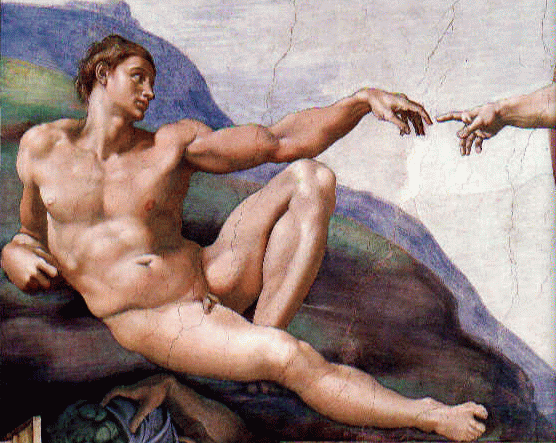 Prescientific cosmologies generally interpret the universe in strictly
human terms. Early cosmologies certainly began with basic observations;
the connection between the changes in the skies and the days and seasons is
difficult to miss. Mythological models of the universe sought to render
such observations intelligible and to fit them into a theory of existence.
However, in the mythological worldview, observations were, for the most
part, of secondary importance. They had more to do with
human hopes, desires and preoccupations, including establishing
humanity's place within the universe, an issue with which we still struggle
today.
Prescientific cosmologies generally interpret the universe in strictly
human terms. Early cosmologies certainly began with basic observations;
the connection between the changes in the skies and the days and seasons is
difficult to miss. Mythological models of the universe sought to render
such observations intelligible and to fit them into a theory of existence.
However, in the mythological worldview, observations were, for the most
part, of secondary importance. They had more to do with
human hopes, desires and preoccupations, including establishing
humanity's place within the universe, an issue with which we still struggle
today.
To get an overview of cosmological myths, especially a description of the
primary motifs in these myths, visit:
![]() Cosmogonic Myths
Cosmogonic Myths
Mythology casts ideas and aspects of the universe into human terms. In some respects, this is essential to our comprehension; we can deal with such issues only in terms we can understand, which must, by necessity, be of human construction. The universe is required for us, but we are mistaken if we invert this assertion and assume that humanity is essential to the universe itself. Yet the attitude that humankind occupies a special place in the universe is an overriding theme in almost all mythology. This is anthropocentrism, the belief that humans are important to the universe, which may well have been created especially for their purposes.
For an interesting perspective on the Concept of Gods and Creation Myths, see article titled In the Beginning: Something
Just as young children tend to interpret their worlds as reflections of
themselves; so it was with humanity for most of its history. The earliest
cosmologies were anthropomorphic cosmologies. An anthropomorphism is the
interpretation of what is not human or personal in terms of human or
personal characteristics. Attributing human motivations and emotions to
the cosmos as a whole, or phrasing the existence of the universe in terms
of a literal birth and death, are examples of anthropomorphisms.
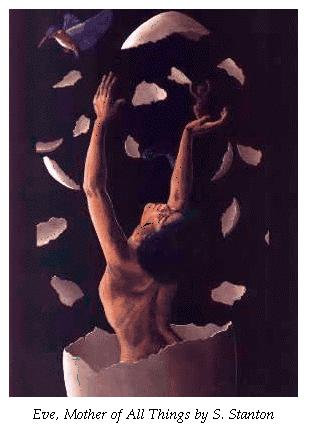
To early peoples, observation seemed to support this viewpoint. The Earth is big, while the Sun and planets and stars seem small. All celestial objects appear to revolve around the Earth. Humans have power over plants and animals. The Earth provides the things that make human life possible, so it must have been created for us. (Early peoples did not generally consider the alternative, that humans require for life what the Earth was able to provide. That is, humans are adapted to the Earth, rather than the Earth being adapted for humans.) In contrast, some phenomena, such as the weather, remain beyond our power. Such things are important, both blessings and curses to humans. Weather brings rain for crops but also storms that destroy. Since anthropocentric cosmologies assume that humans are cardinal, these natural powers demonstrate that a still greater power exists, which is inflicting upon us the good and bad; if we may not be in charge, at least we occupy much of the attention of the powers that are. The aspect of "punishment" is often central, sometimes almost an obsession; humans did wrong and were punished, hence bearing forever the responsibility for death, decay, and imperfection.
One form of an anthropomorphic worldview in animism, the belief that all things are animated by spirits, all of which hold some opinion toward humans, and any of which may actively aid or frustrate human plans. Less purely anthropomorphic cosmologies may hold that some portions of the universe are inanimate but are created and affected by animate beings, perhaps by a pantheon of gods as well as humans.
The trend to anthropomorphism comes from the quite natural tendency of
human cultures to describe the universe with imagery from familiar, and
necessarily human, experiences. When a cosmology is expressed in the form
of a narrative tale that explains or illustrates the beliefs of a culture,
it is said to be a myth. Cosmological myths make the culture's ideas of
the origin and structure of the universe generally intelligible and broadly
accessible. Some of these myths were interpreted quite literally and
anthropomorphically, while others were understood to be only analogies that
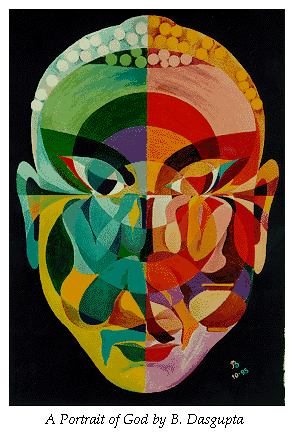 could make the incomprehensible more familiar. Mythology tends to reflect
what is known or important to the culture in which it arose. The myths of
agricultural societies typically revolve around the imagery of the seasons,
of planting and harvesting, while the myths of hunting and gathering
peoples often involve animals which take on human characteristics.
could make the incomprehensible more familiar. Mythology tends to reflect
what is known or important to the culture in which it arose. The myths of
agricultural societies typically revolve around the imagery of the seasons,
of planting and harvesting, while the myths of hunting and gathering
peoples often involve animals which take on human characteristics.
Ancient mythologies still exert a great hold over human beings. Among the many possible examples, the most familiar may well be astrology - the belief that the planets and stars themselves relate to personal actions and destiny. Astrology is one of the oldest systems of belief known. The version that is common in Western countries is based upon a systematization of ancient lore by the Greek scholar Ptolemy, whose Almagest still forms the basis for the casting of horoscopes. Astrology is based upon the supposition that the stars influence our lives in mysterious ways, or foretell our destinies through their motions and configurations. Before there was any understanding of gravity or of the orbits of planets, some explanation had to be devised for the regularity of the celestial motions. In the prevalent anthropocentric view, those motions must surely have something to do with human events. In Greek and Roman belief, the planets were explicitly associated with specific gods and goddesses, whose names they still bear. The five planets known to the ancients, those that are visible with the unaided eye, are Mercury, Venus, Mars, Jupiter, and Saturn. The Sun and Moon were also considered "planets", making seven in all. The days of the week correspond to these seven planets. Sunday is the Sun's day, Monday the Moon's, Tuesday is ruled by Mars. Wednesday is the day of Mercury, Thursday is governed by Jupiter, Friday corresponds to Venus, while Saturday belongs to Saturn.
The gods and goddesses of ancient Rome may have faded to amusing anachronisms, but astrology still holds the attention of many people. Who has not had the experience of reading the appropriate horoscope in the newspaper and finding that it applies perfectly? This is an example of a phenomenon well known to psychologists. People are much more likely to believe very general statements about themselves than they are to believe genuine specific psychological assessments. Moreover, there is the universal tendency to interpret vague descriptions in terms appropriate to the individual reading them. Finally, there is the phenomenon of selective memory, in which "hits" are remembered vividly, while "misses" are forgotten. Even so, if astrology had never been developed, it seems likely that people would be drawn to some similar system, such as "paranormal" phenomena, unidentified flying objects, "channeling" of spirits, past lives, and so forth. Many humans are unwilling to believe that their lives are subject to random occurrences; the wish to seek order in the cosmos is powerful.
Astrology may be easy to ridicule, but other common viewpoints are no less
anthropocentric.
Many of our "unscientific" cosmological ideas, including some most firmly
embedded within the human psyche, have mythological origins. Many genesis
myths can be seen to share common themes. There are three categories of
imagery commonly invoked to explain the beginning of the universe:
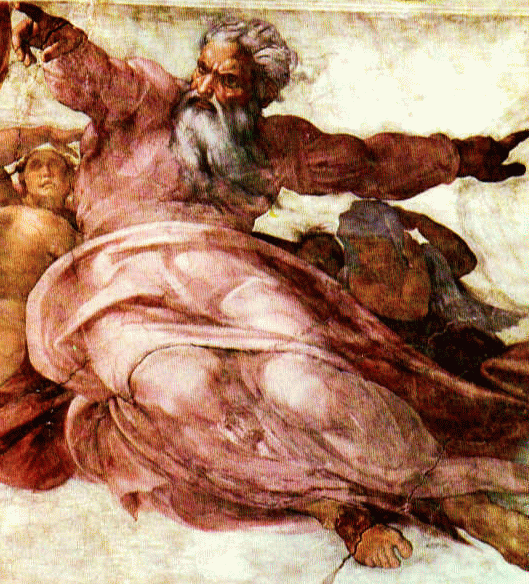
The following are some examples of creation myths; they are not intended
to be comprehensive but the collection does span the range of themes
fairly typical of cosmological mythologies.
The myths of a society spring from that society,
and these examples vividly illustrate this, but myths, once established,
can also mold societies long after they cease to function literally.
If you want to learn about
more about the different creations myths from around the world, visit:
![]() Creation Myths from around the World
Creation Myths from around the World
![]() Genesis Project: Creation Myths
Genesis Project: Creation Myths
![]() Biblical Genesis
Biblical Genesis
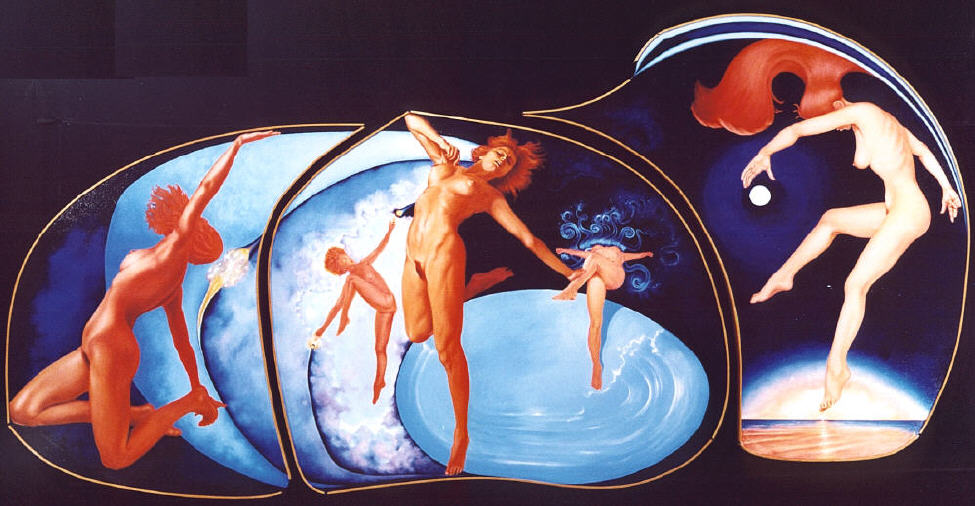
The Enuma Elish is the "Babylonian Genesis." Babylon, a great city of ancient Mesopotamia located near present-day Baghdad, was originally settled by the Sumerians around 3500 BC. The Sumerians irrigated the desert and developed the cuneiform writing system, but they were conquered
by Akkadians and Amorites from the north, and their culture was assimilated and eventually forgotten. The great king Hammurabi, famous as the first ruler known to have written down a code of laws, was an Amorite ruler of Babylon in the eighteenth century B.C., during the height of Amorite power in the region. A few centuries later, however, Babylon and its possessions came under the control of the Kassites, a tribe which may have originated in central Asia. The Enuma Elish dates from the Kassite regime, perhaps around 1450 B.C., though only later copies of it now exist. The second millennium B.C. was a peak period in Babylon's history, and this creation myth was probably composed at least partially with the motive of justifying
the city-state's political power by making its patron deity the chief among the gods.
The story incorporates ancient Sumerian themes, as well as contributions from the later conquerors of Mesopotamia; like many Babylonian myths, it is evocative of later stories indigenous to the Middle East. In this tradition, the tumultuous sea is identified with disorder. The Sumerians and their successors believed that the cosmos began with a chaos of fresh water, sea, and mist. From this confusion, pairs of gods were created representing the silt, the horizon, and the sky, as well as embodying male and female aspects; this echoes the creation of new land in the delta
region of Mesopotamia, between the Tigris and Euphrates Rivers, in what is now Iraq. Following the initial creation, there was conflict between "order" and "evil," in the form of two deities, Marduk, the protector of Babylon, and Tiamat, the sea-goddess, representing chaos. Marduk killed Tiamat and created the Earth from her body, then created humans from the blood of another rebel god, Kingu. The struggle between two powerful deities mirrors the development and nature of human societies: both good and evil are present, while custom and authority create order, backed by the application of force, if necessary.
A Tanzanian myth, although quite different in detail from the Enuma Elish, similarly reflects the lives of the people who created it. In the beginning was "the Word,"which was the creative force; there was also air and sky, a single tree, and some ants who lived on the tree. One day a great wind blew away a branch of the tree, carrying some ants with it. The ants continued to eat from the branch, but soon they ran out of food and were forced to eat their own excrement. The excrement grew into a huge ball, which became the Earth. The Earth eventually enveloped the tree, at which point the Word sent wind and water to Earth; the ants were subsequently destroyed in a flood. But the tree continued to grow, and its roots gave rise to plants on the Earth. The atmosphere then created animals and humans, each kind with its own voice. Fighting over food led to war between humans and animals. The war became so terrible that parts of the Earth broke away to form the stars, the Moon, and the Sun. The Sun glows because it came from a part of the Earth that was on fire when it was separated, while the Moon and stars are transparent disks through which the Sun's light shines. Some of the animals became the slaves of humans, while others remained wild and attacked people. At the end of the war, a sheep kept by humans leapt to the sky, where it killed the Word and ruled the cosmos, bringing thunder and lightning to the Earth. Because of this transgression, humans were punished by the gods when they dared to ask for help after their sheep caused the death of the Word. Humans were made lowly and warned that Earth shall be eventually consumed by fire.
The Hindu creation myth exists in many different forms. They are all considered to be different interpretations of the primary principle of Brahman, which is described as "Everywhere, Nowhere, Everything and Nothing". Creation is described as coming forth from Brahman's thought or by the act of god Brahma, the human representation of Brahman. The following is a version of the creation myth that is particularly interesting, especially in light of material that will be presented in subsequent lectures:
This universe existed in the shape of darkness, unperceived, destitute of distinctive marks, unattainable by reasoning, unknowable, wholly immersed, as it were, in deep sleep.Then the Divine Self-existent, himself indiscernible but making all this, the great elements and the rest, discernible, appeared with irresistible power, dispelling the darkness.
He who can be perceived by the internal organ alone, who is subtle, indiscernible, and eternal, who contains all created beings and is inconceivable, shone forth of his own will.
He, desiring to produce beings of many kinds from his own body, first with a thought created the waters, and placed his seed in them.
That seed became a golden egg, in brilliancy equal to the sun; in that egg he himself was born as Brahma, the progenitor of the whole world....
The Divine One resided in that egg during a whole year, then he himself by his thought divided it into two halves;
And out of those two halves he formed heaven and earth, between them the middle sphere, the eight points of the horizon, and the eternal abode of the waters.
From himself he also drew forth the mind, which is both real and unreal, likewise from the mind ego, which possesses the function of self-consciousness and is lordly.
Moreover, the great one, the soul, and all products affected by the three qualities, and, in their order, the five organs which perceive the objects of sensation.
But, joining minute particles even of those six, which possess measureless power, with particles of himself, he created all beings
Chinese cosmologies were diverse, but all emphasized that the doings of humans, particularly the mandarins of the court, were reflected in the heavens, a preoccupation not surprising in a country which was highly and hierarchically organized from very ancient times. Evil works would show themselves by disruptions in the sky, so the Chinese were keen observers, seeking auguries in the stars. Because of this, and because of the antiquity of the Chinese writing system, the Chinese annals constitute the longest unbroken records of the sky, which has proven important for some aspects of modern astronomical research. For example, the Chinese recorded in detail the supernova of 1054. This "guest star," as they called it, should have been sufficiently bright to have been visible for a short while during the day, yet it is completely absent from European chronicles. Perhaps the Europeans of the time, with their ironclad belief in a perfect, immutable heaven, ignored this strange phenomenon. The Chinese believed that the universe was huge, possible infinite; the Sun, Moon, planets, and stars consisted of vapor and were blown about by a great wind. Many Chinese also accepted that the Earth moved, although like most peoples they did not realize that it rotated; they envisioned, rather, a smooth oscillation they believed to cause the seasons.
A fairly widespread Chinese creation myth tells of the giant Pan Gu. In the beginning, the cosmos was a great egg. For 18,000 years, Pan Gu slept within the egg. Finally he awoke and broke free, shattering the cosmic egg which had contained him. The lighter, purer elements rose and became the heavens, while the heavier, impure elements sank to form the Earth. Pan Gu maintained the separation of Earth and heaven with his body, supporting heaven with his head while his feet rested on the Earth. As the distance between heaven and Earth grew, Pan Gu grew to equal it. Finally heaven and Earth seemed securely in place and Pan Gu died. His breath became the wind, his voice the thunder, and his perspiration the rain; his left eye was transformed into the Sun and his right eye into the Moon. His four limbs became the four directions, his trunk the mountains, while his blood ran as the rivers and his veins laid out roads and paths. His flesh created fields and soil, his skin and hair became the plants of the Earth, while his bones went into rocks and his marrow became the precious gems. After the sacrifice of Pan Gu, the Earth was a pleasing place, but the
goddess Nu Wa, who had the face of a human but the body of a dragon, found it lonely. Stooping by the bank of a pond, she fashioned some amusing little creatures from mud. It was too tiring to create them constantly, so she endowed them with marriage and the capability to reproduce on their own. Later, a great battle between the spirit of water and the spirit of fire resulted in a catastrophe when the fleeing spirit of fire struck the great mountain that supported the western part of the sky. The heavens tilted and ripped apart, while the Earth fissured. Nu Wa melted the prettiest stones from the riverbeds to repair the holes and cracks, then killed a giant turtle, and cut off his legs to form the four pillars that support the sky. But the tilt to the west remained, and thus the Sun and stars slide down it, while on the Earth the water runs eastward into the ocean.
A common theme among many peoples indigenous to the Americas, both North and South, is the primacy of the four directions and of the number four in general. In some Native American cosmologies, these directions correspond to the four cardinal directions also utilized by Europeans, whereas in others, the major directions are those of the rising and setting of the Sun at summer and winter solstices. Some Native American cosmologies add the idea of the center to the directions, making five the principal mystic number. In many American cultures, particularly in the Southwest of the United States and in Mesoamerica, the world has been destroyed and recreated four or five times. Each world consists of layers, typically three; an Upper World of spirits and pure birds, a Middle World of humans and animals, and a Lower World of evil creatures.
The most elaborate cosmologies of this kind were found in Mesoamerica. In Aztec and Maya belief, the cosmos passed through four ages in the past. At the end of each "Sun," a great disaster destroyed the world. The current era, the Fifth Sun, began with the self-sacrifice by fire of Nanhuatl, the ugliest god, who was reborn as the Sun Tonatiuh. After this, the god Teucciztlan, whose courage had faltered at the great bonfire, threw himself into the flames and became the Moon. But the new Sun sullenly refused to rise until it was placated with the sacrifice of hearts and blood. Xolotl,
a twin and aspect of the serpent god Quetzalcoatl, performed the sacrifices of all 1,600 deities present, then sacrificed himself; after this, the Sun rose. Quetzalcoatl ("plumed serpent") was, in many Mesoamerican traditions, a creator god who took several aspects, including the wind god Ehecatl and the monster Xolotl. He was a very important deity in Mesoamerica, especially to the Maya, who called him Kukulkan and associated him with the planet Venus, which as the Morning Star rises in the east just before the Sun, and as the Evening Star was thought to plunge sacrificially into the Sun just after it sets. Mayan astronomers kept meticulous records of Venus, and their observations enabled them to compute the length of the solar year to within a few seconds.
The importance of Quetzalcoatl played a pivotal role in the conquest of Mexico by the Spanish. Legends told of a great battle between Quetzalcoatl and his rival, the jaguar god Tezcatlipoca, after which Quetzalcoatl disappeared, promising to return from the east. The year 1519 corresponded roughly with the year Ce Acatl (One Reed) in the Azteco-Mayan calendar, the date-name associated with Quetzalcoatl as the Morning Star. When Hernán Cortés and his men appeared on the east coast of Mexico, the Aztec emperor Montezuma II took him for a representative of the returning Quetzalcoatl, and sent treasures of gold and silver from his capital of Tenochtitlán. The riches merely whetted the Spaniards' appetites for conquest, and they quickly made alliances with tribes held vassal by the Aztecs. The Conquistadors, hardly the salt of their own society, soon enough demonstrated by their behavior that they were not gods buy merely an unfamiliar and especially rapacious kind of human. Yet Montezuma persisted in his delusion until Cortés appeared at Tenochtitlán and threw the pious emperor into prison. Montezuma was stoned by his own people for his failure to resist the invaders, and he died a few days later. The example of Montezuma should make it apparent that cosmological considerations are not idle speculations but have significant consequences for the individual and society.
Creation myths reflect the values and observations of the cultures that created them. Culture shapes the world view of its society, and conversely. The actions of the society's leaders, for good or ill, can be dictated by the prevailing cosmological mythology. Even in our modern, industrialized societies, many unspoken cosmological assumptions mold our thinking. One of the most significant is the belief that the bounty of the universe is without limit. Although rarely articulated explicitly, this principle pervades many cultures, encapsulating the view that resources and opportunities are infinite. This point of view fits nicely with the attitude that the Earth is here for the benefit of humanity. As has become increasingly apparent in the twentieth century, such an outlook has important, and perhaps disastrous, consequences. Much of economic theory is founded upon the postulate that growth can continue indefinitely; that if we run out of some resource, a substitute can always be found. Yet it is clear that the illusion of boundless resources occurs only because the Earth is much larger than a human being, and geological timescales are much longer than a human lifespan. Our perceptions of the Earth, its history, and its contents, are skewed by our human limitations.
At this point, I would recommend that you go back and read the section
titled Why P303?
before going on to the next section. After reading that page, return to
this page and continue on to the next subsection using the buttons below.

|

|